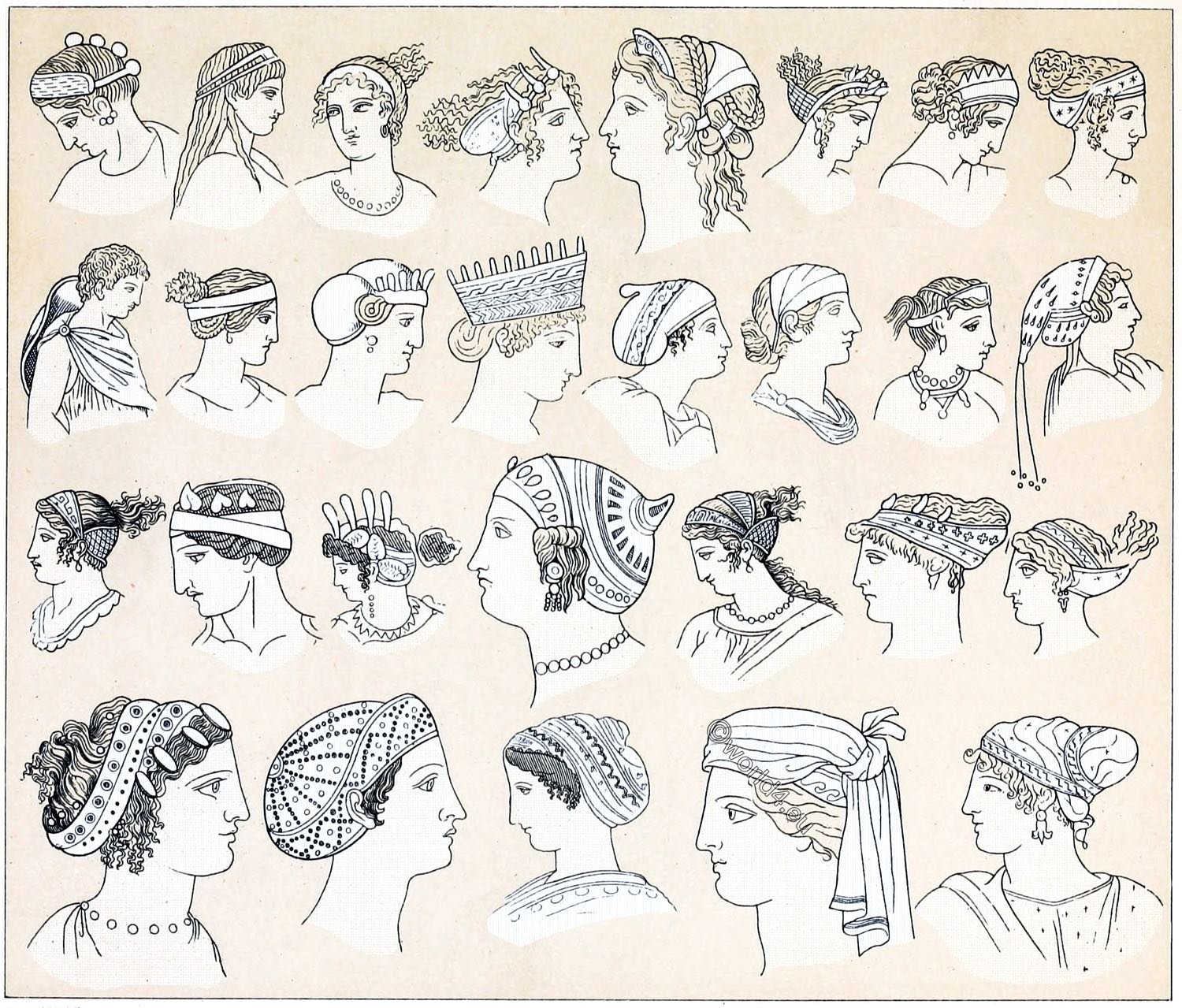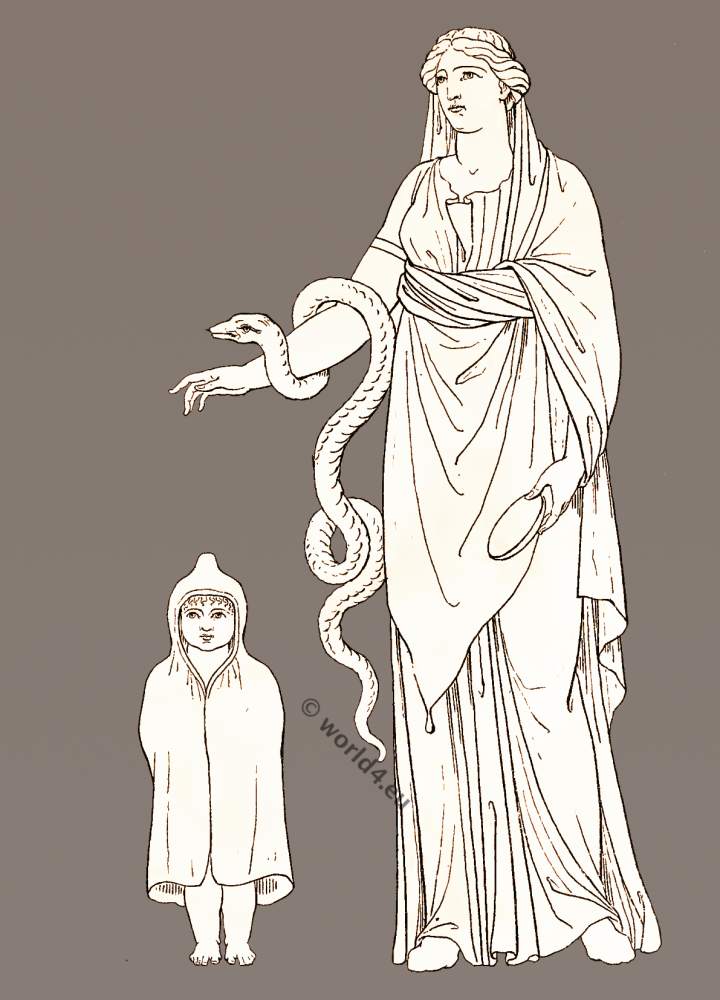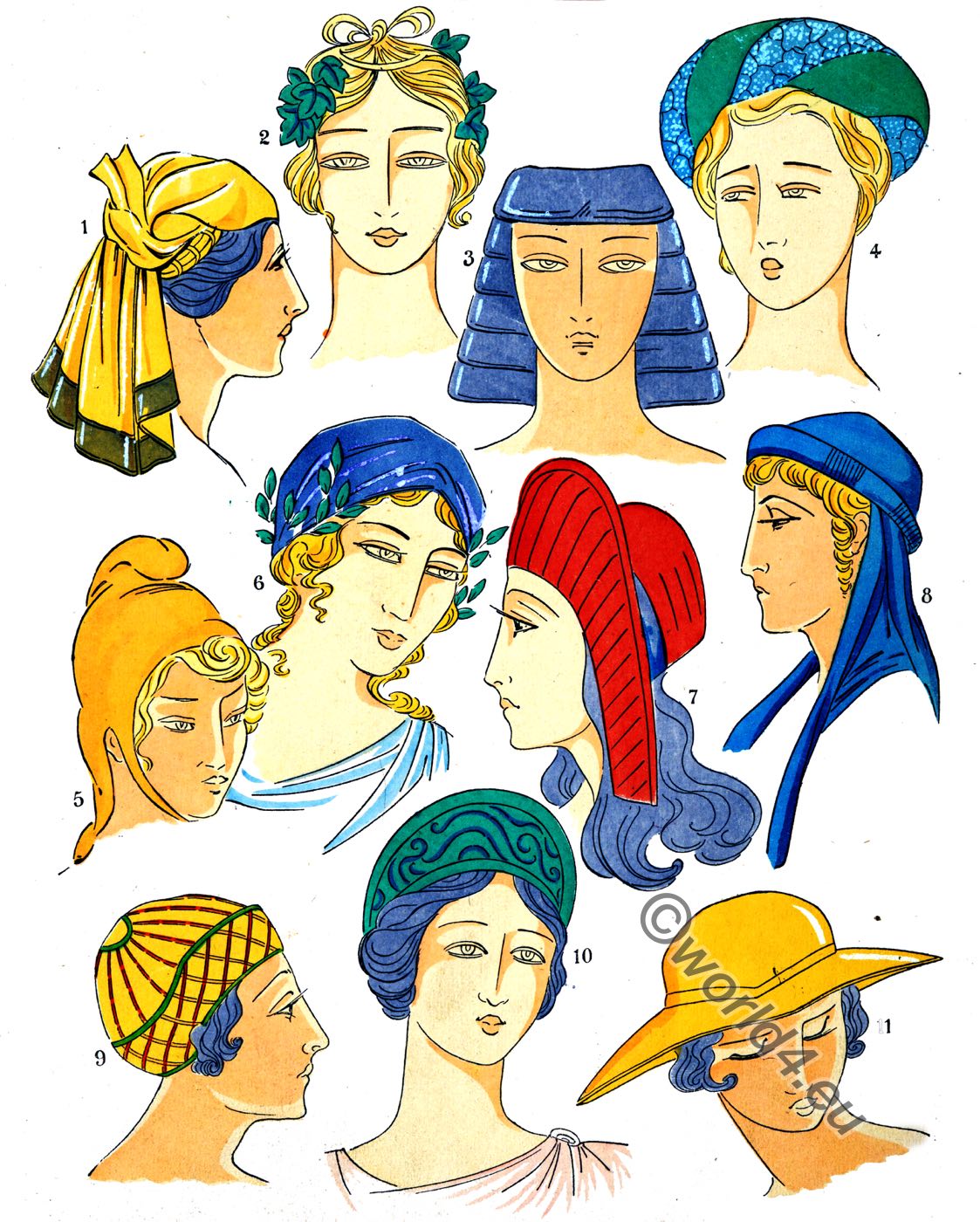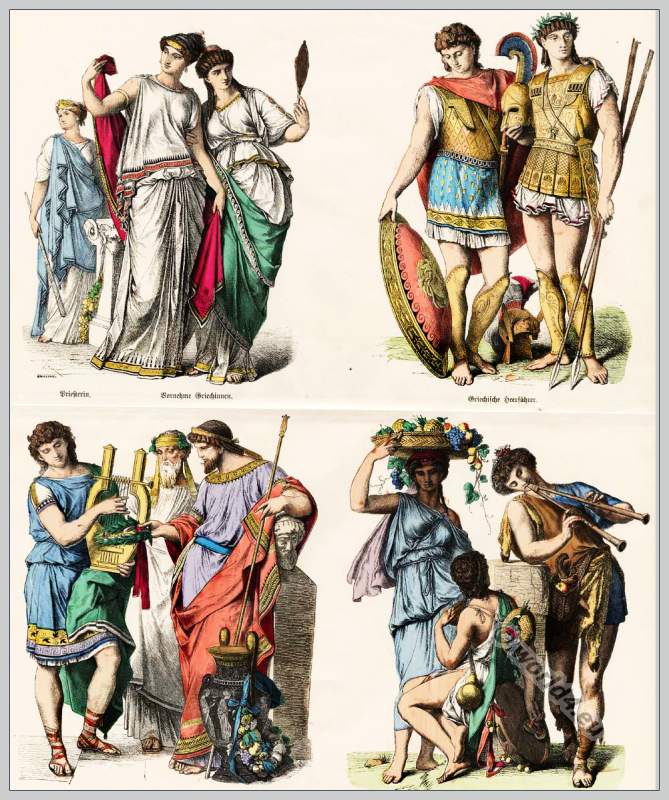
DANCING IN ANCIENT GREECE
The early Greeks considered dancing to be worthy of the gods themselves. Jupiter, for example, is often found dancing in the midst of the deities; and Apollo is not only mentioned by Homer as thus engaged, but he secured the title of “the Dancer” for his supposed skill in the terpsichorean art *). Apollo also personified the close connection between dancing and music: indeed it was sometimes the practice of the musician himself to join in the dance he accompanied, as we see in the painting by Epictetus, where the piper follows the steps of a girl performing a solo dance with castanets. Dancing was also regarded as an essential part of Greek education; and the physicians in the time of Aristophanes recommended it as a health-giving exercise.
*) Terpsichore (ancient Greek Τερψιχόρη ‘the joyful one’, ‘the dancing one’; emphasis on the i: Terpsichore) is one of the nine muses, who are all daughters of Zeus and Mnemosyne. She is the muse of choral poetry and dance and, according to some ancient writers, takes her name from the fact that she delighted her lovers with the seductions that come from erudition. She is said to have first invented dancing and then, after other fine arts, the sciences. In some sources she is seen as the mother of the sirens with the river god Acheloos. Terpsichore is depicted as a nymph crowned with flowers in a light garment, with a lively gesture and as a dancing or sitting virgin. She is usually depicted and described with the attribute of a lyre and a plectrum.
The Greek dance usually took the form of those slow measured movements which Simonides described as “silent poetry”. The people danced everywhere and on any pretext — in the temples, the woods or the fields. In this fashion they welcomed the returning seasons, and celebrated the harvest and the vintage. With dances they commemorated a victory, or did honor to a god. The Dionysiac, for instance, was sacred to Bacchus, the Iambic to Minerva, and the Caryatic to Diana. Dances were also dedicated to Apollo and Artemis; and ballets were performed to represent the births and histories of other deities. These dances were of many kinds; but it is possible to classify them in three general groups: cubistic or square dances, spheristic or round dances, and orchestric or stage dances.
The famous Dionysiac festivals were given over almost entirely to dances, the principal one being the Dithyramb. They were often led by public characters or statesmen. The Emmelia was a slow and graceful measure danced by maidens. The Kardax was performed in connection with comedy and was associated with riotous jollity. Other dances, like the Hyporchoma, were performed both by men and women, taking the form of mimes or dancing and singing games.
On the Greek stage or orchestra the choragus or coryphaeus led the chorus, the members of which, clad in long robes and crowned with palm or laurel, danced with slow measured steps.
Source: Dancing by Charles John Samuel Thompson. London: Collins 1940
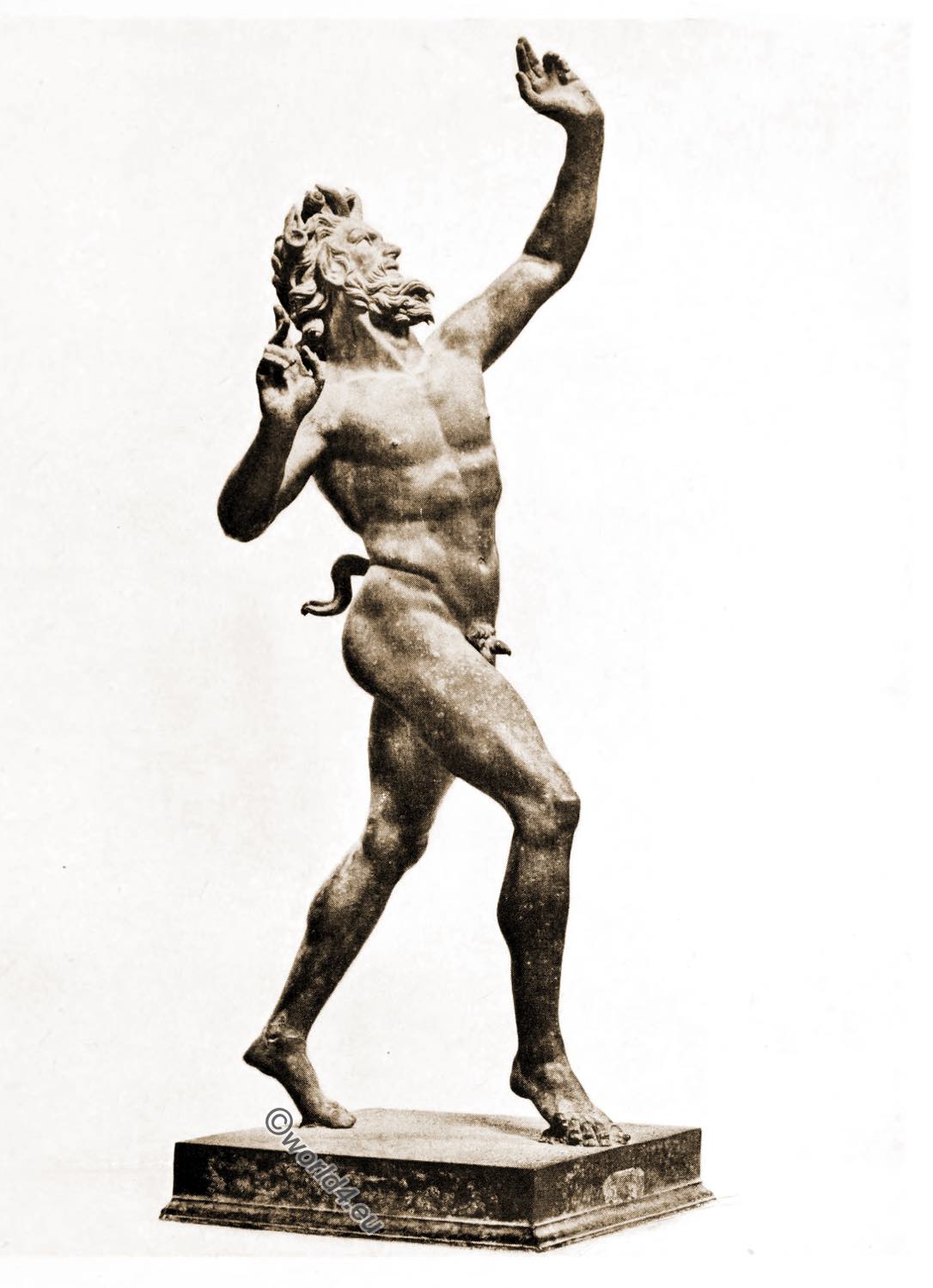
The Dancing Satyr. — From a Greek bronze found in 1831 in the House of the Faun, Pompeii’s largest and most magnificent mansion; now in the Museo Nazionale, Naples.
The Dance
THE DANCING OF GREECE
BEFORE logic, man knew emotion; before creed, ritual. With leap and mad gesture the savage mimics his triumph, to the accompaniment of crude saltation performed by a hero-worshipping tribe.
Not by argument is the coming storm propitiated, but by a unified expression of tribal humility. To the rhythm of beaten drums, the tribe, as one, performs the genuflexions and prostrations that denote supplication and fear.
So on through the gamut of simple emotions- love and hate, fealty and jealousy, desire and achievement- primitive man expresses his mood in terms of the dance. History shows that dancing persists on a plane with words, paint and music as a means of expression, however far a race may advance along the road of evolution; and that the few exceptions to this rule are to be found among peoples who have allowed a Frankenstein of logic to suppress, for a time, their naturalness of spirit.
Egyptian carvings of six thousand years ago record the use of the dance in religious ritual; and abundant evidence attests the importance in which it was held at all times through the period of Egypt’s power. In lines as stately as the columns of a temple, sculptors have traced choreography’s majestic poses, its orchestral repetitions and variations. As a dance may be, the religious dances of Egypt were a translation and an equivalent of the spirit of the Pharaohs’ monumental architecture; that they were no less imposing than those temples we cannot avoid believing.
Plato, deeply impressed by these hierarchical ballets, finds that their evolutions symbolized the harmonious movements of the stars. Modern deduction carries the astronomical theme still further: the central altar is believed to have represented the sun; the choral movements around it, the movements of the celestial bodies. Apis, the sacred black bull, was honored in life by dances of adoration, in death by ballets of mourning.
Either dancing was attributed to the divinities (according to a Christian saint of later centuries; it is the practice of angels) or some of the divinities were represented by dancers in the religious ballets. A carving in the Metropolitan Museum of New York shows Anubis and Horus kneeling, their arms completing a pose that is seen to this day in the dances of Spain.
Important as was the dancing of Egypt as the root from which grows the choreography of all the Occident- and of India too, for anything known to the contrary- the carvings reveal little of its philosophy or symbolism. But the history of other peoples at once demonstrates its force as example, at least, if not as teacher of actual technique. The Hebrews of very early days gave dancing a high place in the ceremony of worship. Moses, after the crossing of the Red Sea, bade the children of Israel dance. David danced before the Ark of the Covenant.

Courtesy of The Metropolitan Museum of Art, New York
TANAGRA FIGURES
Numerous Biblical allusions show that dancing was held in high respect among early leaders of thought. “Praise the Lord . . . praise Him with timbrel and the dance,” is commanded. With dancing the Maccabees *) celebrated that supremely solemn event, the restoration of the Temple. To honor the slayer of Goliath, the women came out from all the cities of Israel, “singing and dancing . . . with tabrets **), with joy and with instruments of music.” Relative to the capture of wives the sons of Benjamin were told: “. . . if the daughters of Shiloh come out to dance in dances, then come ye out of the vineyards, and catch you every man his wife … and the children of Benjamin did so, and took them wives, according to their number, of them that danced, whom they caught” (Judges 21:21 and 23). “Thou shalt again be adorned with thy tabrets, and shalt go forth in the dances of them that make merry” (Jeremiah 31 4). “Then shall the virgin rejoice in the dance” (Jeremiah 31:13). “And David danced before the Lord with all his might” (2 Samuel 6:14). In the solemn chapter of Matthew narrating the beheading of John the Baptist we read: “But when Herod’s birthday was kept, Salome the daughter of Herodias danced before them, and pleased Herod. Whereupon he promised with an oath to give her whatever she would ask.”
*) The Maccabees were the leaders of a Jewish uprising against the Seleucid Empire and the local groups supported by it. After their victory, they established the royal and high priestly dynasty of the Hasmoneans and fought for a hundred years (165 BC to 63 BC) for hereditary rule over the Jews. The Jewish Hanukkah festival dates back to the events of that time.
**) The timbrel or tabret was the main percussion instrument of the ancient Israelites. It resembled either a frame drum or a modern tambourine.

Perhaps with an idea of forestalling discussion of the art’s antiquity, one of the early writers eliminates argument by a simple stroke of the pen. “The stars conform to laws of co-ordinated movement. ‘Co-ordinated movement’ is the definition of dancing, which therefore is older than humanity.” Taking this at its face value, human institutions are thrown together into one period, in which differences of a thousand years are as nothing.
In turning to Greece, years need lend no aid to make the subject attractive. In that little world of thought we find choreography luxuriant, perhaps, as it never has been since; protected by priesthood and state, practised by rich and poor, philosopher and buffoon. Great mimetic ballets memorialized great events; simple rustic dances celebrated the gathering of the crops and the coming of the flowers. Priestesses performed the sacred numbers, the origins of which tradition attributed to Olympian gods; eccentric comedy teams enlivened the streets of Athens; gilded youth held dancing an elegant accomplishment.
Philosophers taught it to pupils for its effect on body and mind; it was a means of giving soldiers carriage, agility and health, and cultivating esprit de corps. To the development of dancing were turned the Greek ideals of beauty, which in their turn undoubtedly received a mighty and constant uplift from the beauty of harmonized movements of healthy bodies. Technique has evolved new things since the days of classic Greece; scenery, music and costume have created effects undreamed of in the early times. But notwithstanding the lack of incidental factors- and one questions if any such lack were not cancelled by the gain through simplicity- the wide spread practice of good dancing, the greatness and frequency of municipal ballets, the variety of emotional and aesthetic motives that dancing was made to express, all combine to give Greece a rank never surpassed as a dancing nation.
The man-made attributes of man’s gods are a synopsis of man’s important thoughts. Cybele, mother of the gods and friend of mankind, taught dancing to the corybantes as a fitting gift to be passed along to her mortal foster-children. Apollo, speaking through the mouths of priestesses, dictated further choreographic laws. Orpheus journeyed to Egypt to study its dances, that he might add to the scope of the Hellenic steps and movements. One of the nine muses was devoted to the fostering of this particular art. All of which shows a profound belief in the Greek mind that dancing was worthy of a great deal of divine attention. Certainly no subsequent civilization has been so well qualified to judge the importance of dancing, for none has experimented so completely in the effect of rhythmic exercise on the body and mind of a nation.
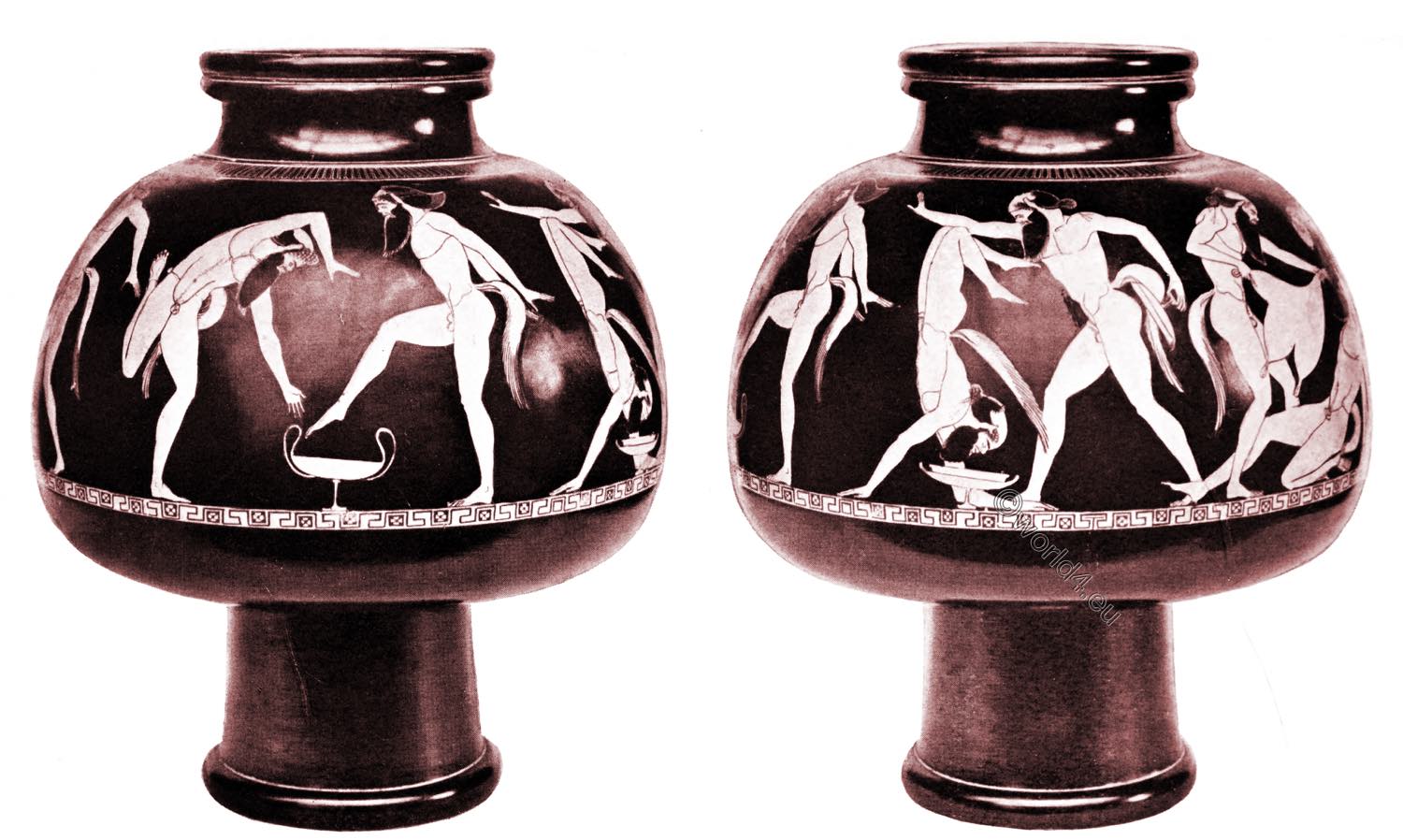
Revels of Satyrs or Sileni. Two scenes from a psycter signed by Duris (5th cent, B.C.) now in the British Museum. In the first, two Sileni are dancing, one on each side of a cantharos placed on the ground; in the second one Silenus is, apparently, trying to drink upside-down from a kylix on the ground, while the other (ithyphallic) holds a kylix in his left hand and with his right makes a gesture of admiration.
Classic sculpture no more than suggests the importance of dancing in Greek life. An assemblage of a few Greek thinkers’ observations on the subject furnishes an idea of the value they gave it as a factor in education. Plato, for instance, specifies it among the necessities for the ideal ‘republic, “for the acquisition of noble, harmonious, and graceful attitudes.” Socrates urged it upon his pupils. Physicians of the time of Aristophanes prescribed its rhythmic exercise for many ailments. Lycurgus gave it an important place in the training of youth, military and otherwise. Among the special dances whose teaching he decreed, was one, the Hormos, that was traditionally performed without clothing. Plutarch tells of a protest against the nudity of the women. The Law-giver of Athens replied: “I wish them [the women] to perform the same exercises as men, that they may equal men in strength, health, virtue and generosity of soul, and that they may learn to despise the opinion of the vulgar.”
Of great men’s dancing in public there are instances. in abundance. The very method of choosing the leaders of great civic choreographic spectacles insured the association of people of consequence, for these leaders were always selected from the highest rank of citizens. Epaminondas, Antiochus, and Ptolernaeus are variously mentioned for their skill in dancing, as well as their prominence in national affairs. Sophocles danced around the trophies of the battle of Salamis. AEschylus and Aristophanes danced in various performances of their own plays. And Socrates, one of the very fathers of human reasoning, danced among friends after dinner. Aristides danced at a banquet given by Dionysius of Syracuse. Anacreon, in his odes, declares that he is always ready to dance.
Professional dancers enjoyed high prestige. Philip of Macedon had one as a wife; the mother of Nicomedes, king of Bithynia, was a dancer. Aristodemus, a famous dancer of Athens, at one time was sent to the court of Philip of Macedon as ambassador.
This chapter must not be understood as trying to represent that Athenian civil life was given over to an endless round of choreographic celebration; nor have the later chapters concerning the courts of the Louis any intent to picture a set of beings whose minds were devoted to dancing to the exclusion of all else. What is intended, however, is to call attention to an important omission in the writings of the general historian,’ who never has given dancing its due proportion of consideration as a force in those and other high civilizations. Literature and the graphic arts followed the coming of civilization, and are among its results; they have been analyzed with all degrees of profundity. The dance is, undoubtedly, among the causes of Greek vigor of mind and body; but it is of far less concern to the average historical writer than any disputed date. The microscopist charting the pores of the skin knows nothing of the beauty of the figure. And the grammarian’s myopic search for eccentricities of verb-forms atrophies his ability to perceive the qualities of literature, until finally he will try to convince his listeners that literary quality is, after all, a subject for the attention of smaller minds.
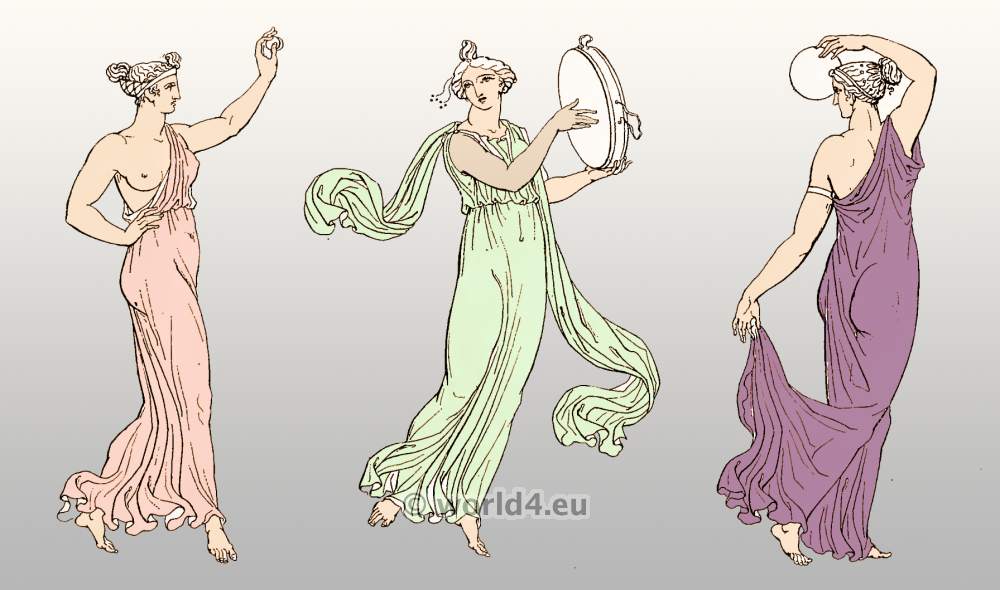
Greek philosophy, mathematics, political and military science are part of the structure of Occidental society- a good and useful part. Had the importance of the dance been appreciated-had proper authority recognized its inherent part in the Greek social organism -who can say how much dulness, ugliness and sickliness of body and spirit the world might have escaped?
Folk-dancing has been introduced into the public schools of certain cities; a movement too new to be judged. Let it be neither praised nor censured until results have had time to assert themselves. If at the end of ten years the children who have danced their quota of minutes per day do not excel in freedom from nervous abnormalities, the children who have not danced; if they fail to manifest a better co-ordination of mind and body, and a superior power of receiving and acting upon suggestion-then let public school dancing be abolished as of no value beyond amusement and exercise.
Of recent years a good deal of ingenuity has gone into study of the dances of classic Greece, with view to their re-creation. From paintings on vases, bas-reliefs and the Tanagra statuettes has been gathered a general idea of the character of Greek movement. The results have been pleasing, and in Miss Duncan’s case radical, as an influence on contemporary choreographic art. But, beautiful and descriptive as they are, the plastic representations are of scattered poses from dances not as a rule identified. If, therefore, present-day re-creations often fail to show the flights of cumulative interest common in modern ballet, Spanish and Slavonic work, the shortcoming is due at least in part to the lack of explicit records of sequences of step, movement and pantomimic symbol. For it is impossible to believe that the dance composers of the age of Pericles did not equal their successors, even as their contemporaries in the fields of sculpture, architecture and poetry left work never yet excelled.
Of the names and motives of dances the record seems to be pretty complete. Sacred, military and profane are the general categories into which the very numerous Greek dances divide themselves. The sacred group falls into four classes: the Emmeleia, the Hyporchema, the Gymnopaedia, and the Endymatia. Of these the two latter seem to have been colored by sentiments more or less apart from the purely religious.
Of the Emmeleia, Plato records that some had the character of gentleness, gravity and nobility suitable to the sentiments by which a mortal should be permeated when he invokes the gods. Others were of heroic or tragic aspect, emphasizing majesty and strength. A characteristic of this group was its performance without accompaniment of chorus or voice. The origin of the group is attributed to Orpheus, as a fruit of his memories of Colchis and Saïs.
The Hyporchema, equally religious, were distinguished by their use of choral accompaniment. In some cases it might be more accurate to say that the dances were an accompaniment to recited poetry; for in very early times the dances seem to have been employed to personify, or materialize, the abstractions of poetic metaphor. Both men and women engaged in dances of this group, and its plane was of lofty dignity. In it were the oldest dances of Greece, besides some composed by the poet Pindar.
The Gymnopaedia were more or less dedicated to the worship of Apollo, and were especially cultivated in Arcadia. As the name implies, the performers were nude-youths wearing chaplets of palm. A material character seems to have marked this group: Athenseus finds in it points of identity with the Anapale, which is known to have been a pantomimic representation of combat.
The Endymatia crossed the border-line between the sacred and profane. They were brightly costumed dances, and in demand for general entertainment. In connection with this group we find the first allusion to the highly modern institution of dancers’ “private engagements”-professionals aiding in the entertainment of dinner-parties. The Greek and Roman custom of seeing dancers instead of listening to after-dinner speeches is too well known to justify more than a mention.
These four groups are the fundamentals from which numberless other dances were derived, to be variously dedicated to gods, public events, abstract qualities, crops, and fighting. If no particular occasion offered, people would dance for the good reason that they felt like it, as Neapolitans dance the Tarantella to-day. To the glory of Bacchus were the Dionysia; the Iambic was sacred to Mars, the Caryatis, a dance symbolizing innocence, and danced nude, to Diana. Hercules, Theseus, the daughters of Jupiter, Castor and Pollux were so honored- each dance having its special identification of movement, meaning or costume.
Semi related to the religious group were the dances of mourning. Unlike certain modern dances of the same intent, these are not recorded as having been primarily an individual’s pantomimic dance representing qualities of the deceased, or illustrating his relations during life with friends and family; although there was a time in which the cortège was headed by an individual dressed in the clothes of the deceased, imitating his virtues and sometimes also his failings. Regularly, however, the dancing was strictly ritualistic, forming a solemn decorative concomitant of the vocal and instrumental music. (At what point in his evolution did the Occidental determine that his ritualistic expressions should be directed almost exclusively to the ear?) A corps of fifteen girls danced before the funeral car, which was surrounded by a band of youths. Naturally the brilliancy of the function was more or less proportionate to the station and estate of the departed.
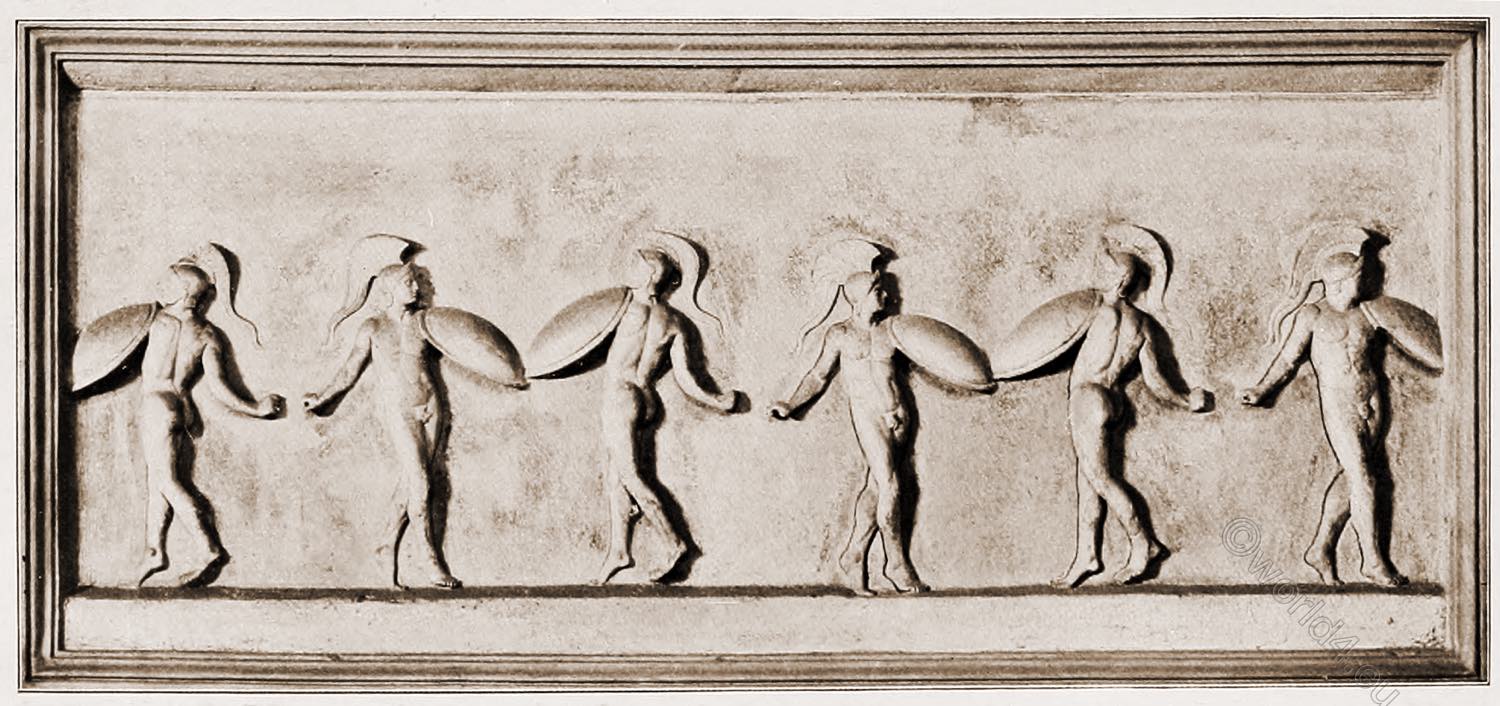
On dances of war the Greeks relied as an important element in the soldier’s training. In their pantomime the veteran lived over the moments of combat, while his children and even his wife caught anew the spirit of Hellenic arms.
Plutarch wrote: “The military dance was an indefinable stimulus which inflamed courage and gave strength to persevere in the paths of honor and valor.” It is still known that a body of men moving in step feel fatigue distinctly less than when walking out of step. One of the things learned by the long-distance runner, the wood-cutter, or any other performer of continued work, is the importance of establishing as quickly as possible a regular rhythmic relation between the separate parts of a complete movement, including the intake and expulsion of breath among those parts. Such a rhythm once established, movement succeeds movement with something like momentum; the several steps, or blows of the axe, do not each require a separate effort of the will. Something of this was Plutarch’s “indefinable stimulus.”
Apart from efficiency of the individual, experience has shown that a command moving “in time” is unified in the fullest sense, with each soldier more or less perfectly proof against any impulse at variance with the esprit de corps. “To weld a number of men ever more closely into the condition of a military unit is one of the purposes of drill. Drill is in great part a matter of keeping in step. The Greeks carried to a high pitch the unification of a military body in respect to all the movements of attack and defense. History repeatedly records the demoralization of the enemy, carried by the assaults of the perfectly organized Greek fighting bodies. But undoubtedly an important value of the study for perfection of corps unity was the disciplinary effect on the Greek soldier himself.
As a means toward such perfection, Greek law prescribed dancing for the soldier. An obvious benefit from his practice of the art was the advantage due to mere muscular exercise; and that in itself is no small thing when the dance is performed in full armor, as the Greek soldier performed it.
Authorities. classify the military dances as Pyrrhic and Memphitic; but the division seems hardly essential, since the meagre technical descriptions draw no distinct line between the two groups. In both, performers carried sword or spear and shield. The movements brought in the maneuvers of individual combat-cutting and thrusting, parrying, dodging and stooping. That they might be carried to a degree of realism is indicated in a description by Xenophon. At the end of a mimic combat between two Thracians, at the conclusion of which the victor sang a song of victory and possessed himself of the vanquished man’s weapons, the spectators cried out with emotion, believing that the fallen man was killed.
Of the words “Pyrrhic” and “Memphitic,” the latter seems to connote a performance less insistent on the element of combat. To Minerva is credited the origin of the Meniphitic group, legend having it that the goddess of wisdom composed these dances to celebrate the defeat of the Titans. The usual accompaniment was the flute, according with the idea of comparative tranquillity. Both styles were danced by women; special fame for proficiency was given to the vigorous daughters of Sparta, Argos, and Arcadia, and to the Amazons.
Pantomime was important in most Greek dances. Greek writers interested themselves in an effort to trace pantomime to its origin; but they were not very successful, because they went no further back than the demigods. Whereas sign-talk, if inference may be drawn from savages, antedates spoken language-which is beside the point of the present sketch.
Pantomime artists of Greece were of various ranks, according to the plane of thought represented in their work. Ethologues represented moralities; they “depicted the emotions and the conduct of man so faithfully, that their art served as a rigorous censorship and taught useful lessons,” writes De l’Aulnaye, in De la Saltation Théâtrale. They were not only artists, but philosophers of a moral standard of the utmost height and purity: the poems of one of them, Sophron of Syracuse, were among the writings kept at hand by Plato during his last hours.
Rich in scope was the Greek stage; and, until later days, generally high in plane. For its effects it drew upon poetry, music, dancing, grouping and posing. Little is known of the music; re-creations of it (how authoritative the authors do not know) are simple and melodious, with no attempt at grandeur. But in the other departments, what veritable gods in collaboration! Euripides, Aristophanes, and AEschylus are of those who supplied texts. Sculptors whose works are no less perishable gave their knowledge to grouping and posing.
Of the merit of the performers there is no adequate record, for lack, among other things, of an explicit choreographic terminology. (This deficiency was first made up in the French language, after the organization of the National Academy of Music and Dancing, in the seventeenth century.) What is known, however, is that dancing was considered a proper medium of expression of great motives, and that great-minded artists chose it as a career; not in spite of a public condescension to it, but with the support of a profound public respect.
Accuracy of rhythm is of an importance obvious to grades of intelligence far below that of the Greeks. They laid stress no less on what may be called rhythmic quality than on mere emphasis of tempo. A time marker was provided with an assortment of sandals soled with metal or wood of various thicknesses; by means of these he produced sounds consistent with the changing sentiments of the action. (Compare the modes of getting varied sounds from castanets, in chapter on Spanish dancing.) Castanets, too, were used in Greece, essentially the same as those of Spain to-day; also fiat sticks in pairs, like clappers, but which unlike clappers were gripped between the thumb and fingers. Little cymbals on the dancers’ hands sometimes added their voice, and the tambourine was popular. The variety of these time-marking instruments indicates knowledge of the many effects attainable by tempo alone. Indeed a reading of the poets emphasizes this: their selection of words for sound as well as meaning will force even a mediocre reader into an observance of the author’s intention of ritard and accelerando, legato and staccato, emphasis and climax. Associated with ballet production, as the ablest poets were, it may be taken as assured that the devices of tempo were made familiar to dancers-unless it was the dance that taught the metre to the poets.
Masks were worn to identify character; but their primary function appears to have been the concealment of a sound-magnifying device to carry the voice through the great spaces of out-door theaters. Women’s parts in the ballets were played by men at least frequently; whether the reverse was a conspicuous exception is also uncertain. Both usages were destined to survive in pantomime through centuries. Objection to the mask always was overruled by authority; the Greek play was such an irreproachable organism that deviation from its accepted formulas was deemed an impious and dangerous heresy. In the eighteenth century a premier danseur’s absence put a French ballet director temporarily at the mercy of the second dancer, a young radical, who refused to “go on” wearing a mask. Not until then was the mask tradition disturbed.
Though exact data of the steps of popular dances are lacking, literary allusions record dance names and general character in great number. A complete catalogue of them would offer little inspiration to the lay student or the professional; no more than a hint of their broad scope is necessary. Dances suggesting the life of animals were plentiful. Some were underlaid with a symbolic significance, as that of the crane, the bird’s confused wanderings representing the efforts of Theseus to find his way out of the labyrinth, the legend in its turn probably having some relation to life and the tricks it plays on its possessors.
The fox was a favorite subject, and the lion was not overlooked. Though the author of Chanticler may have been the first to avail himself of the grotesqueries of poultry, the Greeks danced owls and vultures. Similar to the Oriental Danse du Ventre was the Kolia, probably brought across from Egypt. Another suggestion of North Africa was known in Greek language as the Dance of Spilled Meal – what more reasonable than to Infer that it was the same in scheme as the Flour Dance of present-day Algeria? The flour or meal that identifies this performance is spread on the floor, and a more or less involved design traced in it. What follows is interesting chiefly as a test of a species of virtuosity: the dancer’s object is, in her successive turns across and about the design, to plant her feet always within the same spaces, the loose meal exposing any failure. Rapidity of tempo and involution of step may raise the difficulties to a point beyond the reach of any but the most skillful. The children’s game of Hop-scotch is a degenerated kinsman of the dance in and over a design.
There were dances of satyrs and goats, nymphs, monkeys, gods and goddesses, flowers, grapes and the winepress. Combat was rendered into poetry in the Spear Dance) the Fight with the Shadow, the fights with shields, with swords. There were “rounds,” performed by an indefinite number of people joining hands in a ring; traces of these are said to survive as peasant dances of the Greece of to-day. There were solos, pas de deux and pas de quatre. Pythagoras made a period of dancing a part of the daily routine of his pupils, Hymeneia were danced to help celebrate a well conducted wedding. Prayers, sacrifices and funerals, as stated before, were incomplete without their several and special dances.
Movement no less than speech is a vehicle for satire, wit, sensuality and indecency. Theophrastus, with the intent of showing the degree of shamelessness to which erring humanity may fall, tells of a man who performed a dance called the Cordes without the excuse of being drunk at the time of the deed. Covering a wide range of light motives was the Sikinnis, the word being applied both to a certain dance and to a form of satirical mimodrama. In the latter sense it burlesqued the politics, philosophy and drama of the day. As all peoples divide themselves into masses and classes on lines of taste as well as of money, so also eventually the Athenians. In the hands of the Athens rabble-catered to perhaps by ancestors of certain twentieth-century managers-the Sikinnis, as a satire, fell into the slough of vulgarity.
As a dance it may be thought of as a favorite of that Alcibiades type of youth in whom education has not depressed Arcadian frivolity. How such a one vexed the solemnity of a court is the subject of an anecdote compiled by Herodotus. Clisthenes, king of Sicyon, in order to marry his daughter to the greatest advantage, decided to settle the selection of her husband by competition. The invitation met with due interest on the part of the rich and the great. Suitors came from far and near, among them two from Athens. An ominous circumstance, for “Attic salt” was out of the same barrel as the “sal de Andalucia” of to-day; both have the record of becoming operative immediately on exposure to any air of over solemnity.
After days of regal festivity, Clisthenes dedicated a hecatomb to the gods, gave a final banquet, and announced that the suitor-selecting competition would be along the lines of music and poetry. When it came to the turn of Hippoclides, one of the two Athenians, he asked that a table be brought in. On this he mounted, stood on his hands, and traced the figures of a Sikinnis in the air with his feet!
Until the king’s temper was quite gone, the performance was received in silence. Herodotus supposed that Hippoclides interpreted the silence as encouragement; but Herodotus very clearly did not know that kind of boy. The polished though inverted youth on the table was estimating the horror among his worthy spectators, and luxuriating.
Greece, with her fine simplicity of thought, furnished the pattern on which was cut the civilization of early Rome; Greek art, the concrete expression of her lofty thought, furnished Rome a model. Which model Rome followed until loot and tribute provided her with means to express the taste that was her own.
The dance; its place in art and life by Troy Kinney; Margaret West Kinney. New York : Frederick A. Stokes company 1914.
Related
Discover more from World4 Costume Culture History
Subscribe to get the latest posts sent to your email.

